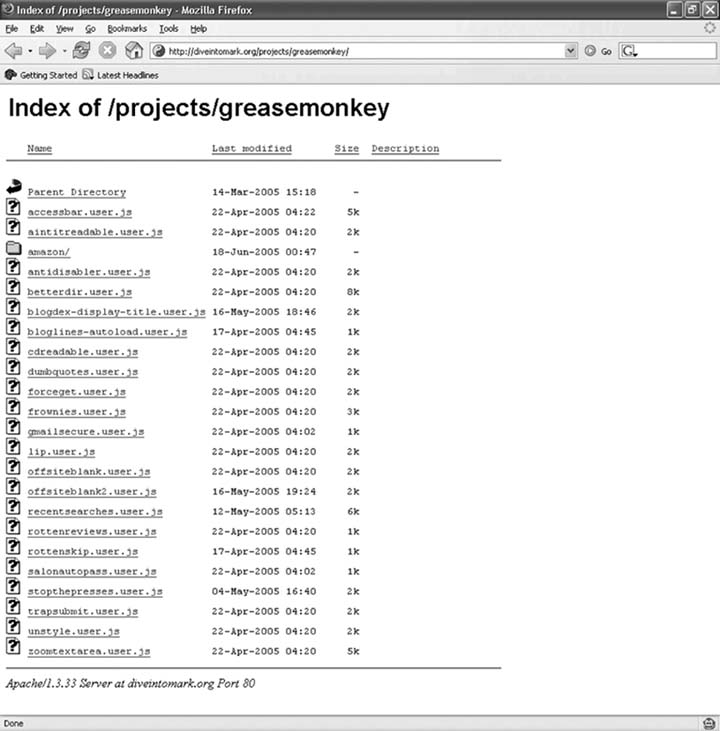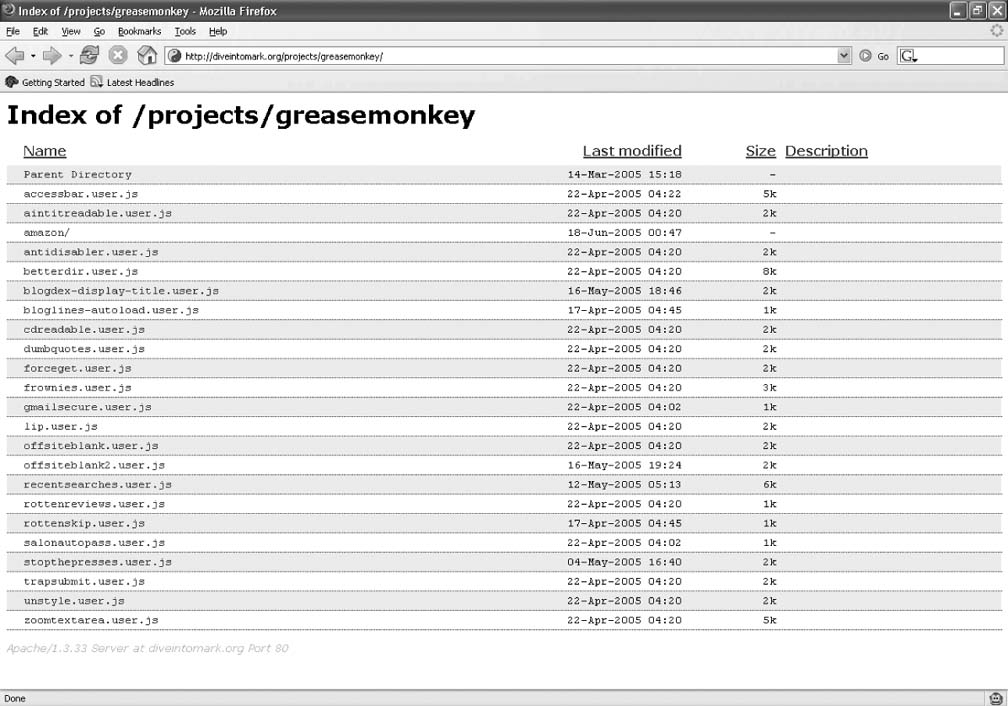Hack 74. Make Apache Directory Listing Prettier
| < Day Day Up > |
|
Enhance Apache's autogenerated directory listing pages with semantic, accessible tables. Have you ever visited a page to find nothing but a plain list of files? If a folder has no default web page, the Apache web server autogenerates a directory listing with clickable filenames. Nothing fancy, but it works, so why complain? Because we can do better! This hack takes the raw data presented in Apache directory listings and replaces the entire page with a prettier, more accessible, more functional version. 8.9.1. The CodeThis user script runs on all pages. Of course, not all pages are Apache directory listings, so the first thing the script does is check for some common signs that this page is a directory listing. Unfortunately, there is no foolproof way to tell; recent versions of Apache add a <meta> element in the <head> of the page to say that the page was autogenerated by Apache, but earlier versions of Apache did not do this. The script checks for three things:
If all three of these conditions are met, the script assumes the page is an Apache directory listing, and proceeds to parse the preformatted text to extract the name, modification date, and size of each file. It constructs a table (using an actual <table> element what a concept) and styles alternating rows with a light-gray background. Save the following user script as betterdir.user.js: // ==UserScript== // @name BetterDir // @namespace http://diveintomark.org/projects/greasemonkey/ // @description make Apache 1.3-style directory listings prettier // @include * // ==/UserScript== function addGlobalStyle(css) { var elmHead, elmStyle; elmHead = document.getElementsByTagName('head')[0]; if (!elmHead) { return; } elmStyle = document.createElement('style'); elmStyle.type = 'text/css'; elmStyle.innerHTML = css; elmHead.appendChild(elmStyle); } // if page title does not start with "Index of /", bail if (!(/^Index of \//.test(document.title))) { return; } // If we can't find the PRE element, this is either // not a directory listing at all, or it's an // Apache 2.x listing with fancy table output enabled var arPre = document.getElementsByTagName('pre'); if (!arPre.length) { return; } var elmPre = arPre[0]; // find the column headers, or bail var snapHeaders = document.evaluate( "//a[contains(@href, '?')]", document, null, XPathResult.UNORDERED_NODE_SNAPSHOT_TYPE, null); if (!snapHeaders.snapshotLength) { return; } // Tables aren't evil, they're just supposed to be used for tabular data. // This is tabular data, so let's make a TABLE element var elmTable = document.createElement('table'); // give the table a summary, for accessibility elmTable.setAttribute('summary', 'Directory listing'); var elmCaption = document.createElement('caption'); // the "title" of the table should go in a CAPTION element // inside the TABLE element, for semantic purity elmCaption.textContent = document.evaluate("//head/title", document, null, XPathResult.FIRST_ORDERED_NODE_TYPE, null).singleNodeValue.textContent; elmTable.appendChild(elmCaption); var elmTR0 = document.createElement('tr'); var iNumHeaders = 0; for (var i = 0; i < snapHeaders.snapshotLength; i++) { var elmHeader = snapHeaders.snapshotItem(i); // column headers go into TH elements, for accessibility var elmTH = document.createElement('th'); var elmLink = document.createElement('a'); elmLink.href = elmHeader.href; elmLink.innerHTML = elmHeader.innerHTML; // give each of the column header links a title, // to explain what will happen when you click on them elmLink.title = "Sort by " + elmHeader.innerHTML.toLowerCase( ); elmTH.appendChild(elmLink); elmTR0.appendChild(elmTH); iNumHeaders++; } elmTable.appendChild(elmTR0); var sPreText = elmPre.innerHTML; if (/<hr/.test(sPreText)) { sPreText = sPreText.split(/<hr.*?>/)[1]; } var arRows = sPreText.split(/\n/); var nRows = arRows.length; var bOdd = true; for (var i = 0; i < nRows; i++) { var sRow = arRows[i]; sRow = sRow.replace(/^\s*|\s*$/g, ''); if (!sRow) { continue; } if (/\<hr/.test(sRow)) { continue; } var arTemp = sRow.split(/<\/a>/); var sLink = arTemp[0] + '</a>'; if (/<img/.test(sLink)) { sLink = sLink.split(/<img.*?>/)[1]; } sRestOfLine = arTemp[1]; arRestOfCols = sRestOfLine.split(/\s+/); var elmTR = document.createElement('tr'); var elmTD = document.createElement('td'); elmTD.innerHTML = sLink; elmTR.appendChild(elmTD); var iNumColumns = arRestOfCols.length; var bRightAlign = false; for (var j = 1 /* really */; j < iNumColumns; j++) { var sColumn = arRestOfCols[j]; if (/\d\d:\d\d/.test(sColumn)) { elmTD.innerHTML += ' ' + sColumn; } else { elmTD = document.createElement('td'); elmTD.innerHTML = arRestOfCols[j]; if (bRightAlign) { elmTD.setAttribute('class', 'flushright'); } elmTR.appendChild(elmTD); } bRightAlign = true; } while (iNumColumns <= iNumHeaders) { elmTR.appendChild(document.createElement('td')); iNumColumns++; } // zebra-stripe table rows, from // http://www.alistapart.com/articles/zebratables/ // and http://www.alistapart.com/articles/tableruler/ elmTR.style.backgroundColor = bOdd ? '#eee' : '#fff'; elmTR.addEventListener('mouseover', function( ) { this.className = 'ruled'; }, true); elmTR.addEventListener('mouseout', function( ) { this.className = ''; }, true); elmTable.appendChild(elmTR); bOdd = !bOdd; } // copy address footer -- probably a much easier way to do this, // but it's not always there (depends on httpd.conf options) var sFooter = document.getElementsByTagName('address')[0]; var elmFooter = null; if (sFooter) { elmFooter = document.createElement('address'); elmFooter.innerHTML = sFooter.innerHTML; } window.addEventListener('load', function( ) { document.body.innerHTML = ''; document.body.appendChild(elmTable); if (elmFooter) { document.body.appendChild(elmFooter); } }, true); // now that everything is semantic and accessible, // make it a little prettier too addGlobalStyle( 'table {' + ' border-collapse: collapse;' + ' border-spacing: 0px 5px;' + ' margin-top: 1em;' + ' width: 100%;' + '}' + 'caption {' + ' text-align: left;' + ' font-weight: bold;' + ' font-size: 180%;' + ' font-family: Optima, Verdana, sans-serif;' + '}' + 'tr {' + ' padding-bottom: 5px;' + '}' + 'td, th {' + ' font-size: medium;' + ' text-align: right;' + '}' + 'th {' + ' font-family: Optima, Verdana, sans-serif;' + ' padding-right: 10px;' + ' padding-bottom: 0.5em;' + '}' + 'th:first-child {' + ' padding-left: 20px;' + '}' + 'td:first-child,' + 'td:last-child,' + 'th:first-child,' + 'th:last-child {' + ' text-align: left;' + '}' + 'td {' + ' font-family: monospace;' + ' border-bottom: 1px solid silver;' + ' padding: 3px 10px 3px 20px;' + ' border-bottom: 1px dotted #003399;' + '}' + 'td a {' + ' text-decoration: none;' + '}' + 'tr.ruled {' + ' background-color: #88eecc ! important;' + '}' + 'address {' + ' margin-top: 1em;' + ' font-style: italic;' + ' font-family: Optima, Verdana, sans-serif;' + ' font-size: small;' + ' background-color: transparent;' + ' color: silver;' + '}'); 8.9.2. Running the HackBefore installing the user script, go to http://diveintomark.org/projects/greasemonkey/. There is no default page for this directory, so Apache automatically generates a plain-text directory listing, as shown in Figure 8-13. Now, install the user script (Tools Figure 8-13. Plain Apache directory listing When you hover over a file, the entire row is highlighted, as shown in Figure 8-15. Also, when you hover over one of the column headers, you will see a tool tip explaining that you can click to sort the directory listing, as shown in Figure 8-16. I've probably seen thousands of autogenerated directory listings, and it wasn't until I wrote this hack that I realized that you could click a column header to change the sort order. Usability matters! Figure 8-14. Enhanced Apache directory listing Figure 8-15. Row highlighting Figure 8-16. Column sorting |
| < Day Day Up > |
EAN: 2147483647
Pages: 168
 Install This User Script) and refresh http://diveintomark.org/projects/greasemonkey/. The user script replaces the plain directory listing with an enhanced version, which contains a real table with alternating rows shaded, as shown in Figure 8-14.
Install This User Script) and refresh http://diveintomark.org/projects/greasemonkey/. The user script replaces the plain directory listing with an enhanced version, which contains a real table with alternating rows shaded, as shown in Figure 8-14.